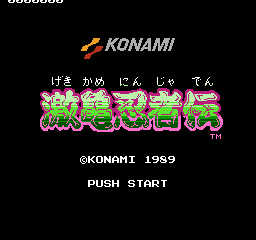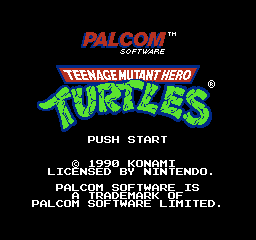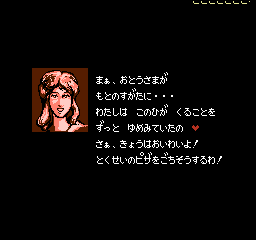If you appreciate the work done within the wiki, please consider supporting The Cutting Room Floor on Patreon. Thanks for all your support!
Teenage Mutant Ninja Turtles (NES)
| Teenage Mutant Ninja Turtles |
|---|
|
Also known as: Gekikame Ninja Den (JP), Teenage Mutant Hero Turtles (EU)
|
The first Teenage Mutant Ninja Turtles game for consoles, it is a ridiculous unbalanced single-player only platformer for the NES where you can switch between the four turtles at any time, with each one essentially acting as a glorified extra life. While the game sold remarkably well thanks to the massive popularity of the cartoons and toys at the time, it was quickly overshadowed by the 4-player arcade game released around the same period. Who knew people wanted to play a game about a group of four brothers with friends?
Contents
Sub-Page
| Prototype Info |
Unused Graphics
Bebop/Rocksteady/Fire Freak Flinching
Unused animation frames for Rocksteady, Bebop and Fire Freak in what seems to be a flinching state, similar to Shredder's. These, however, go unused because none of these characters flinch from anything.
Mini Technodrome
Graphics for a miniature Technodrome with two frames of animation. It is grouped with the graphics for the enemies that appear inside the Technodrome, possibly hinting that it might have been an enemy, but was eventually scrapped.
Thanks
Grouped with the graphics for Area 3's boss and captive Splinter is a rough speech bubble reading "THANKS", but no character ever says this.
Heart
During the ending sequence, the game loads a heart symbol, which is only displayed in the Japanese ending text. The heart was slightly modified to look less stretched in the international releases, but the ending never uses it.
Open Turtle Van
An unused frame for the van in Area 3. It never appears open in-game.
Regional Differences
| To do: Script comparison between the Japanese and English versions of the game. The kana in the Japanese version is stored all over the place, since the game wasn't originally planned to support Japanese text. |
| Japan | US | Europe |
|---|---|---|

|

|

|
The game was localized for the Japanese market before any other form of TMNT media (such as the movie and the animated series) reached the country. As a result, Konami decided to rebrand the game under a completely different title, Geki Kame Ninja Den, which is composed of five kanji characters that literally translates to "Radical Turtle Ninja Legend". Subsequent games in the series released in Japan stuck to the franchise's actual English title.
In Europe, the game (and the franchise itself) is titled Teenage Mutant Hero Turtles, due to the U.K.'s British Board of Film Classification censoring any media associated with ninjas.
The Japanese version of the game is substantially identical to the American and European releases, aside from the text. One particular liberty that the Japanese localization took was the fact that April addresses Splinter as otōsan (father)...not because of any local custom or formality, but simply because they decided to turn April into Splinter's daughter.
In the Japanese version, a sound effect plays when doors open in the cutscenes after areas 2 & 4, which is not heard in the American and European releases.
In the Japanese version, the colour of the logo in the character selection screen doesn't change when choosing another turtle.
The Teenage Mutant Ninja Turtles series
| |
|---|---|
| Arcade | Teenage Mutant Ninja Turtles • Turtles in Time |
| NES | Teenage Mutant Ninja Turtles (Prototype) • The Arcade Game • The Manhattan Project • Tournament Fighters |
| DOS | Teenage Mutant Ninja Turtles (1989) |
| Game Boy | Fall of the Foot Clan • Back From the Sewers • Radical Rescue |
| SNES | Turtles in Time • Tournament Fighters |
| Genesis | The Hyperstone Heist • Tournament Fighters |
| PlayStation 2 | Teenage Mutant Ninja Turtles • Mutant Nightmare |
| GameCube, Xbox | Teenage Mutant Ninja Turtles |
| Game Boy Advance | Teenage Mutant Ninja Turtles • Battle Nexus • TMNT |
| Nintendo DS | Mutant Nightmare |
| Linux | Shredder's Revenge |
| Nintendo Switch, PlayStation 4, Xbox One, PlayStation 5 | Shredder's Revenge • Mutants Unleashed |
| Xbox Series X | Mutants Unleashed |
| Windows | Teenage Mutant Ninja Turtles • Shredder's Revenge • Mutants Unleashed |
| See Also | |
| Nickelodeon | |
- Pages missing developer references
- Games developed by Konami
- Pages missing publisher references
- Games published by Konami
- Games published by Ultra Games
- Games published by Palcom Software
- NES games
- Arcade games
- Pages missing date references
- Games released in 1989
- Games released in May
- Games released on May 12
- Games released in June
- Games with unused graphics
- Games with regional differences
- Pages with a Data Crystal link
- To do
- Teenage Mutant Ninja Turtles series
Cleanup > Pages missing date references
Cleanup > Pages missing developer references
Cleanup > Pages missing publisher references
Cleanup > To do
Games > Games by content > Games with regional differences
Games > Games by content > Games with unused graphics
Games > Games by content > Pages with a Data Crystal link
Games > Games by developer > Games developed by Konami
Games > Games by platform
Games > Games by platform > Arcade games
Games > Games by publisher > Games published by Konami
Games > Games by publisher > Games published by Konami > Games published by Palcom Software
Games > Games by publisher > Games published by Konami > Games published by Ultra Games
Games > Games by release date > Games released in 1989
Games > Games by release date > Games released in June
Games > Games by release date > Games released in May
Games > Games by release date > Games released in May > Games released on May 12
Games > Games by series > Teenage Mutant Ninja Turtles series
The Cutting Room Floor > Unimportant Awards > NES games

